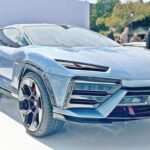

After a long wait, Toyota prepares to revive the legendary off-roader, the FJ Cruiser. The recently released rendering images showcase the silhouette of the next-generation FJ Cruiser, which boasts a robust impression and unique design, fitting its nickname, the Baby Land Cruiser. The model evolves beyond retro styling, incorporating Toyota’s latest design language.
The new FJ Cruiser will likely launch in the first half of 2026. It is expected to be around 4.5 meters (177 inches) long, with a wheelbase of 2,750 mm (108.3 inches), positioning it closer to an off-roader than a crossover. Analysts suggest it will target compact urban SUVs like the Genesis GV70, Ford Bronco Sport, and Jeep Compass, as its size is larger than the Corolla Cross but slightly smaller than the RAV4.

Practical and Tough Exterior
Inheriting Off-Roader DNA
The design of the next-generation FJ Cruiser blends elements from Toyota’s past compact cruiser EV concept with the styling of the traditional Land Cruiser. The boxy body features boldly protruding fender flares, a trapezoidal bumper, and thick C-pillars, capturing the quintessential off-roader essence. The roofline is longer and more gently sloped than before, promising increased interior cargo space.
The vehicle in the renderings adopts a robust protective garnish with bold lines and an understated bumper design. It emphasizes toughness through underbody protection plates and smoked A, B, and C pillars. Unlike before, the spare tire is not mounted on the tailgate; a horizontal tail light is incorporated, adding to the design’s depth.
The narrow, elongated grille features Toyota lettering, and hammerhead-style headlights span across both sides. This maintains Toyota’s latest design direction while subtly reviving iconic elements from the original FJ Cruiser.

Launching with an Internal Combustion Engine
Reviving the Off-Roader Craze
While the powertrain remains unconfirmed, multiple news outlets report that the new FJ Cruiser will initially launch with an internal combustion engine. The base model will likely feature rear-wheel drive, while higher trims have a four-wheel drive system.
Although a hybrid powertrain has been mentioned, no specific details have been confirmed yet. However, considering the carbon regulations in North America and Europe, it is likely that some form of electrified version will be introduced. Direct integration with the compact Cruiser EV, which is an electric vehicle, seems unlikely at this point.
Above all, this vehicle’s positioning is clear. Unlike small crossovers that only adopt the SUV exterior for urban use, the next-generation FJ aims to revive the true essence of an off-roader. This trend aligns with the growing demand for off-road vehicles in markets like the U.S., Australia, and Japan. We can expect significant reactions from the market when this model is released.
























